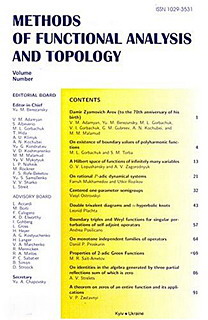Vol. 18 (2012), no. 3
Sectorial classes of inverse Stieltjes functions and L-systems
MFAT 18 (2012), no. 3, 201-213
201-213
We introduce sectorial classes of inverse Stieltjes functions actingon a finite-dimensional Hilbert space as well as scalar classes ofinverse Stieltjes functions based upon their limit behavior at minusinfinity and at zero. It is shown that a function from theseclasses can be realized as the impedance function of a singularL-system and the operator $\tilde A$ in a rigged Hilbert spaceassociated with the realizing system is sectorial. Moreover, it isestablished that the knowledge of the limit values of the scalarimpedance function allows to find an angle of sectoriality of theoperator $\tilde A$ as well as the exact angle of sectoriality of theaccretive main operator $T$ of such a system. The corresponding newformulas connecting the limit values of the impedance function andthe angle of sectoriality of $\tilde A$ are provided. Application ofthese formulas yields that the exact angle of sectoriality ofoperators $\tilde A$ and $T$ is the same if and only if the limitvalue at zero of the corresponding impedance function (along thenegative $x$-axis) is equal to zero. Examples of the realizingL-systems based upon the Schrodinger operator on half-line arepresented.
A new metric in the study of shift invariant subspaces of $L^2(\mathbb{R}^n)$
M. S. Balasubramani, V. K. Harish
MFAT 18 (2012), no. 3, 214-219
214-219
A new metric on the set of all shift invariant subspaces of $L^2(\mathbb{R}^n)$ is defined and the properties are studied. The limit of a sequence of principal shift invariant subspaces under this metric is principal shift invariant is proved. Also, the uniform convergence of a sequence of local trace functions is characterized in terms of convergence under this new metric.
Maps of 2-manifolds into the plane
A. M. Bondarenko, A. O. Prishlyak
MFAT 18 (2012), no. 3, 220-229
220-229
We define a $p$-graph and describe how it changes under isotopy of projections for classification of maps of $2$-manifolds into plane. The problem of graph implementation and maps classification are considered.
Intertwining properties of bounded linear operators on the Bergman space
MFAT 18 (2012), no. 3, 230-242
230-242
In this paper we find conditions on $\phi, \psi\in L^{\infty}(\mathbb D)$ that are necessary and sufficient for the existence of bounded linear operators $S,T$ from the Bergman space $L_a^2(\mathbb D)$ into itself such that for all $z\in \mathbb D,$ $ \phi(z)=\langle Sk_z, k_z, \rangle, \psi(z)=\langle Tk_z, k_z \rangle$ and $C_aS=TC_a$ for all $a\in \mathbb D$ where $C_af=f\circ \phi_a$ for all $f\in L_a^2(\mathbb D)$ and $\phi_a(z)=\frac{a-z}{1-\bar a z}, z\in \mathbb D.$ Applications of the results are also discussed.
Schrödinger operators with $(\alpha\delta'+\beta \delta)$-like potentials: norm resolvent convergence and solvable models
MFAT 18 (2012), no. 3, 243-255
243-255
For real functions $\Phi$ and $\Psi$ that are integrable and compactly supported, we prove the norm resolvent convergence, as $\varepsilon\to0$, of a family $S_\varepsilon$ of one-dimensional Schrödinger operators on the line of the form $$ S_\varepsilon= -\frac{d^2}{d x^2}+\alpha\varepsilon^{-2}\Phi(\varepsilon^{-1}x)+\beta\varepsilon^{-1}\Psi(\varepsilon^{-1}x). $$ The limit results are shape-dependent: without reference to the convergence of potentials in the sense of distributions the limit operator $S_0$ exists and strongly depends on the pair $(\Phi,\Psi)$. A class of nontrivial point interactions which are formally related the pseudo-Hamiltonian $-\frac{d^2}{dx^2}+\alpha\delta'(x)+\beta\delta(x)$ is singled out. The limit behavior, as $\varepsilon\to 0$, of the scattering data for such potentials is also described.
Controlled fusion frames
Amir Khosravi, Kamran Musazadeh
MFAT 18 (2012), no. 3, 256-265
256-265
We use two appropriate bounded invertible operators to define a controlled fusion frame with optimal fusion frame bounds to improve the numerical efficiency of iterative algorithms for inverting the fusion frame operator. We show that controlled fusion frames as a generalization of fusion frames give a generalized way to obtain numerical advantage in the sense of preconditioning to check the fusion frame condition. Also, we consider locally controlled frames for each locally space to obtain new globally controlled frames for our Hilbert space. We develop some well known results in fusion frames to the controlled fusion frames case.
Abstract interpolation problem in generalized Nevanlinna classes
MFAT 18 (2012), no. 3, 266-287
266-287
The abstract interpolation problem (AIP) in the Schur class was posed by V. Katznelson, A. Kheifets, and P. Yuditskii in 1987. In the present paper we consider an analog of AIP for the generalized Nevanlinna class $N_κ(L)$ in the nondegenerate case. We associate with the data set of the AIP a symmetric linear relation $\hat A$ acting in a Pontryagin space. The description of all solutions of the AIP is reduced to the problem of description of all $L$-resolvents of this symmetric linear relation $\hat A$. The latter set is parametrized by application of the indefinite version of Kreın’s representation theory for symmetric linear relations in Pontryagin spaces developed by M. G. Kreın and H. Langer in [22] and a formula for the $L$-resolvent matrix obtained by V. Derkach and M. Malamud in [11].
The integration of operator-valued functions with respect to vector-valued measures
MFAT 18 (2012), no. 3, 288-304
288-304
We investigate the $H$-stochastic integral introduced in [24]. It is known that this integral generalizes the classical Ito stochastic integral and the Ito integral on a Fock space. In the present paper we construct and study an extension of the $H$-stochastic integral which will generalize the Hitsuda-Skorokhod integral.


